Almost from their inception, the Latter Day Saints (Mormons) were greeted with mistrust and persecution by their neighbors. This led to their exodus from New York (where they formed their first church in April 1830), then Ohio, then Missouri. Animosity and violence between Mormons and their neighbors in northwestern Missouri became so great in 1838 that historians have referred to this as the “Mormon War,” and it culminated with a shocking government act.
On 27 October 1838, Missouri Governor Lilburn W. Boggs issued an official order to the state militia declaring:
“The Mormons must be treated as enemies, and must be exterminated or driven from the state if necessary for the public peace – their outrages are beyond all description.”
The Mormons came to Missouri because founder Joseph Smith Jr. declared in 1831 that the City of Zion should be established in Jackson County, Missouri. The incoming flood of Mormons disturbed the local residents and antagonisms formed. The Mormons’ growing population became a political force, representing a cohesive voting block often at odds with established politicians.
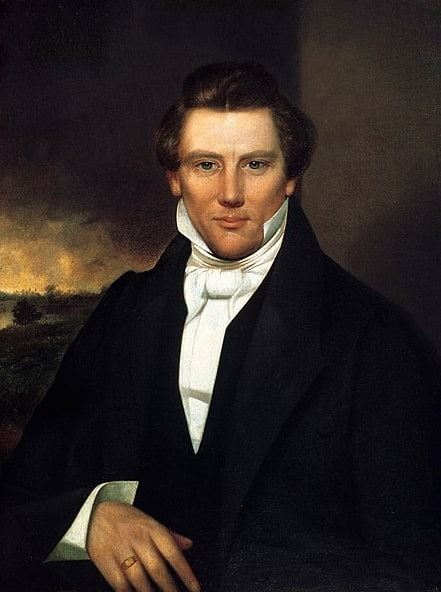
The Mormons were culturally different from their neighbors, held religious views that seemed peculiar and even threatening to mainstream Christians, and were abolitionists in a state where slavery was legal. They also owned huge swaths of valuable and highly desirable land. These differences caused difficulties between the Mormons and their neighbors wherever they settled in Missouri.
The Mormons were forcibly evicted from Jackson County in October 1833. The Mormons tried to settle in Clay County but problems persisted. Attempting to solve the growing discord by separating the Mormons, the Missouri General Assembly in December 1836 created Caldwell County for the Mormons, with the county seat (and Mormon headquarters) at a town called Far West. There was peace for about a year and a half, and the Mormon population in Far West grew to 4,000.
However, distrust and discord between the Mormons and their neighbors came to the forefront once again, and the period known as the Mormon War erupted into violence, destruction and bloodshed. The hostilities began on 6 August 1838, with an election-day conflict in the town of Gallatin, and ended on 1 November 1838, when Joseph Smith Jr. and other Mormon leaders surrendered at Far West. In all, 22 people were killed, many families were driven from their homes, property was stolen, and dozens of buildings were burned.
Some historians say the Mormon War was precipitated by a fiery speech Mormon leader Sidney Rigdon delivered during Fourth of July celebrations in Far West. Speaking on 4 July 1838, Rigdon swore the Mormons would never again allow their Missouri neighbors to persecute them, declaring:
“And that mob that comes on us to disturb us, it shall be between us and them a war of extermination; for we will follow them until the last drop of their blood is spilled; or else they will have to exterminate us, for we will carry the seat of war to their own houses and their own families, and one party or the other shall be utterly destroyed.”
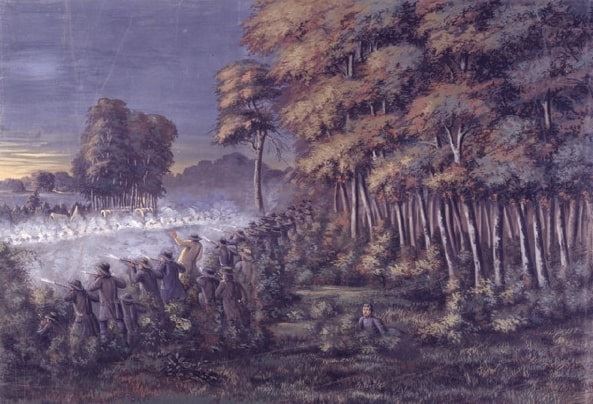
Ridgon’s inflammatory use of the word “extermination” would come back to haunt the Mormons when Governor Boggs issued his infamous extermination order on 27 October 1838. The incident that prompted Governor Boggs’s controversial order is known as the Battle of Crooked Creek. State militia led by Samuel Bogart were stationed in the area to keep the peace. Bogart’s men began disarming Mormons and took three as prisoners. When a Mormon party came to rescue the prisoners, shooting broke out and four men were killed: three Mormons and one member of the militia.
Governor Boggs received greatly exaggerated reports that almost all of Bogart’s men had been slaughtered by the Mormons, and he reacted by ordering the state militia to exterminate or expel all Mormons from the state. His order is known as Missouri Executive Order 44, and it was directed to General John B. Clark of the Missouri State Militia. (Boggs’s extermination order was not officially rescinded by Missouri until 138 years later, when Governor Christopher S. Bond did so on 25 June 1976.)
At the war’s conclusion, an estimated 10,000 Mormons left Missouri. Their leader Joseph Smith Jr. escaped custody in the spring of 1839 and joined their relocation to Illinois, forming their new city of Nauvoo. However, the Mormons were again subjected to intolerance and persecution by their new neighbors in Illinois, and Smith was assassinated by an angry mob on 27 June 1844. The Mormons would not know peace until Brigham Young led a group of Mormon pioneers to Utah’s Salt Lake Valley on 24 July 1847, to found a new community.
The following four newspaper articles present different perspectives on the 1838 Mormon War in Missouri. The first article is wholly supportive of the Mormons and sympathetic to their struggles, even though it calls them “deluded people.”
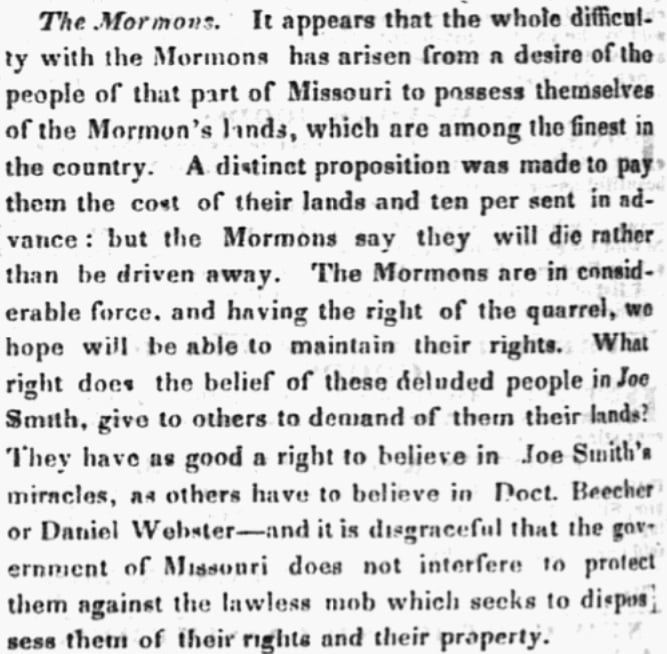
Here is a transcription of this article:
The Mormons.
It appears that the whole difficulty with the Mormons has arisen from a desire of the people of that part of Missouri to possess themselves of the Mormons’ lands, which are among the finest in the country. A distinct proposition was made to pay them the cost of their lands and ten per cent in advance; but the Mormons say they will die rather than be driven away. The Mormons are in considerable force, and having the right of the quarrel, we hope will be able to maintain their rights. What right does the belief of these deluded people in Joe Smith, give to others to demand of them their lands? They have as good a right to believe in Joe Smith’s miracles, as others have to believe in Doct. Beecher or Daniel Webster – and it is disgraceful that the government of Missouri does not interfere to protect them against the lawless mob which seeks to dispossess them of their rights and their property.
Note: This newspaper article contains the incorrect claim that Bogart’s company of militia, “consisting of fifty-four persons, [were] cut to pieces, with the exception of four” that incensed Governor Boggs and prompted him to issue the extermination order. That false claim was printed by the Fayette Democrat (Missouri) on October 27 and reprinted by the Ohio Statesman.
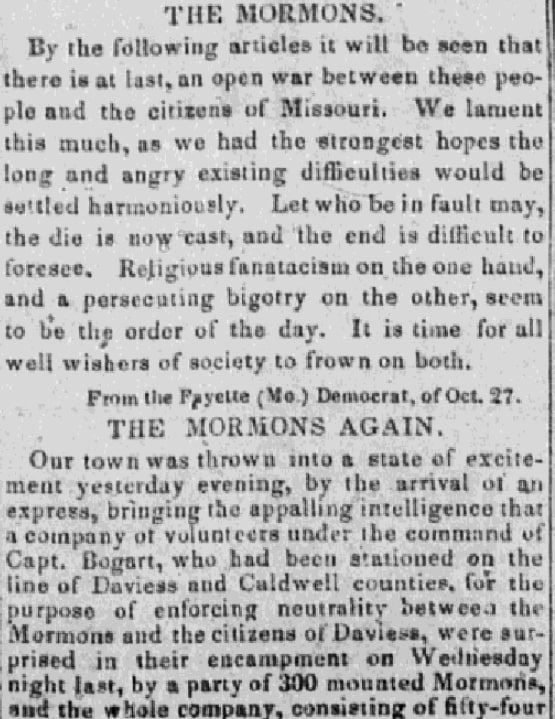
Here is a transcription of this article:
THE MORMONS.
By the following articles it will be seen that there is, at last, an open war between these people and the citizens of Missouri. We lament this much, as we had the strongest hopes the long and angry existing difficulties would be settled harmoniously. Let who be in fault may, the die is now cast, and the end is difficult to foresee. Religious fanaticism on the one hand, and a persecuting bigotry on the other, seem to be the order of the day. It is time for all well wishers of society to frown on both.
From the Fayette (Mo.) Democrat, of Oct. 27.
THE MORMONS AGAIN.
Our town was thrown into a state of excitement yesterday evening, by the arrival of an express, bringing the appalling intelligence that a company of volunteers under the command of Capt. Bogart, who had been stationed on the line of Daviess and Caldwell counties, for the purpose of enforcing neutrality between the Mormons and the citizens of Daviess, were surprised in their encampment on Wednesday night last, by a party of 300 mounted Mormons, and the whole company, consisting of fifty-four persons, cut to pieces, with the exception of four, who succeeded in making their escape. These melancholy tidings are confirmed by letters from highly respectable gentlemen in Ray and Carroll counties, who vouch for their correctness.
Immediately upon the receipt of the above intelligence, a meeting of the citizens was called at the court-house, and every disposition manifested to afford aid to our suffering fellow-citizens. The meeting, without suggesting any definitive course of action, adjourned until today, when an effort will be made to raise a company of volunteers to march forthwith to the scene of disturbance.
Whether the story of the massacre be true or not, the counties of Carroll, Ray, and Daviess are evidently in a great state of excitement and alarm, and something ought to be speedily done by the proper authorities to put an end to these unhappy difficulties, involving as they do the honor and character of the State.
In addition to the foregoing intelligence, we have received a letter from Joseph Dickson, Esq., dated Carrollton, October 24, of which the following is an extract:
“We are all in an uproar here on account of the Mormons. They are pillaging the houses in Daviess county, then burning up the buildings; they even take wagons with them and haul off the plunder. They have threatened to take and burn this place tonight or tomorrow night, and this has been a busy day, I assure you, in packing up goods, wares and merchandise, and all other things of importance, and in carrying them to a place of safety. You may be assured the above statements are true.
“I have pursued the same course of the other citizens, and secured the records and other papers belonging to my offices, as clerk of the circuit and county courts.”
Note: The Cincinnati Gazette (Ohio) printed a report about the Mormons that contained the chilling words: “exterminate or expel them from the State.” That article was reprinted by the Ohio Statesman.
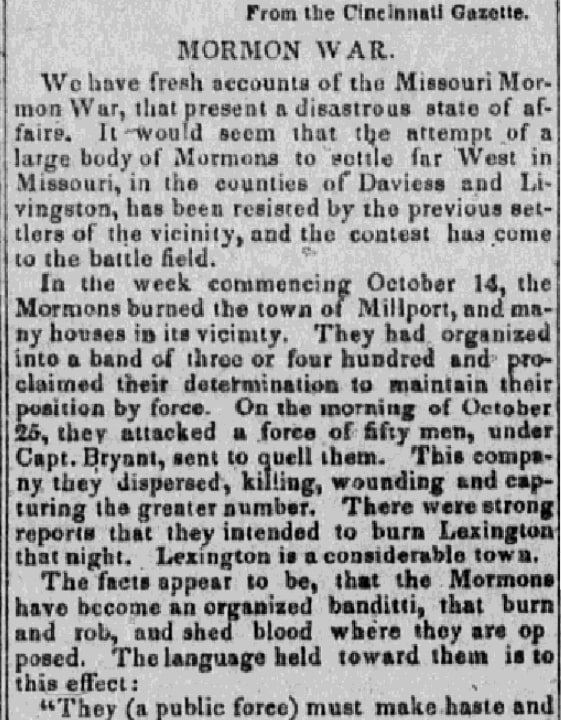
Here is a transcription of this article:
From the Cincinnati Gazette.
MORMON WAR.
We have fresh accounts of the Missouri Mormon War, that present a disastrous state of affairs. It would seem that the attempt of a large body of Mormons to settle far West in Missouri, in the counties of Daviess and Livingston, has been resisted by the previous settlers of the vicinity, and the contest has come to the battle field.
In the week commencing October 14, the Mormons burned the town of Millport, and many houses in its vicinity. They had organized into a band of three or four hundred and proclaimed their determination to maintain their position by force. On the morning of October 25, they attacked a force of fifty men, under Capt. [Bogart], sent to quell them. This company they dispersed, killing, wounding and capturing the greater number. There were strong reports that they intended to burn Lexington that night. Lexington is a considerable town.
The facts appear to be, that the Mormons have become an organized banditti, that burn and rob, and shed blood where they are opposed. The language held toward them is to this effect:
“They (a public force) must make haste and put a stop to the devastation which is menaced by these infuriated fanatics. And they must go prepared and with the full determination to exterminate or expel them from the State, en masse. Nothing but this can give tranquility to the public mind, and reestablish the supremacy of the law. There need be no further dallying with the question anywhere. The Mormons must leave the State, or we will, one and all: And to this complexion it must come at last.”
We are too far from the scenes of action to venture an opinion. Wherever the fault rests, the condition of the parties is most deplorable.
Note: The St. Louis Daily Evening Gazette (Missouri) printed a detailed account of the Mormon War. That article was reprinted by the Salem Gazette.
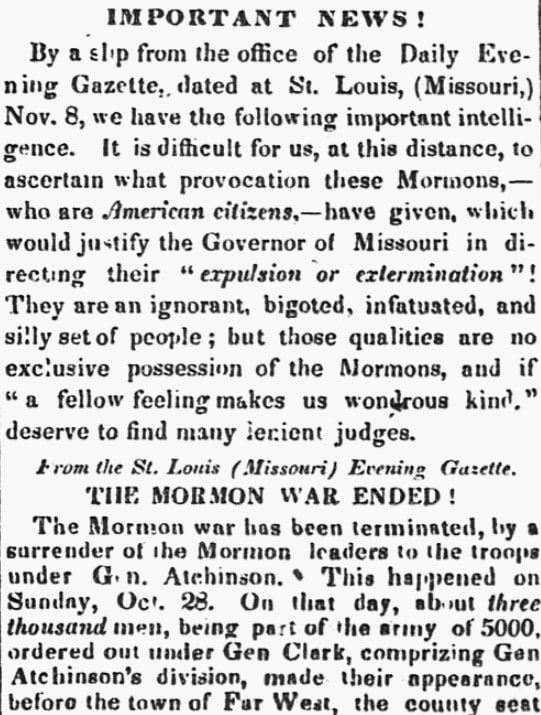
Here is a transcription of this article:
IMPORTANT NEWS!
By a slip from the office of the Daily Evening Gazette, dated at St. Louis, (Missouri), Nov. 8, we have the following important intelligence. It is difficult for us, at this distance, to ascertain what provocation these Mormons – who are American citizens – have given, which would justify the Governor of Missouri in directing their “expulsion or extermination”! They are an ignorant, bigoted, infatuated, and silly set of people; but those qualities are no exclusive possession of the Mormons, and if “a fellow feeling makes us wondrous kind,” deserve to find many lenient judges.
From the St. Louis (Missouri) Evening Gazette.
THE MORMON WAR ENDED!
The Mormon war has been terminated, by a surrender of the Mormon leaders to the troops under Gen. Atchinson. This happened on Sunday, Oct. 28. On that day, about three thousand men, being part of the army of 5000 ordered out under Gen. Clark, comprising Gen. Atchinson’s division, made their appearance before the town of Far West, the county seat of Caldwell County, where the Mormons were entrenched. Upon their approach the Mormons had hoisted a white flag, which was shot down by Capt. Bogart, but was immediately replaced. Gen. Atchinson then sent in a message with a view to learn their wishes and intentions, when six of the leaders avowed their willingness to surrender, in the expectation that the Mormons should be unharmed. The surrender was accepted, and the individuals put under guard. Their names are Joseph Smith, Sidney Rigdon, George Hinkle, Lyman Wight, Parley P. Pratt, and Mr. Knight. The Mormons assembled at Far West comprised 700 men under arms. Of this number, a small body of 150 retreated and pursued their way to the northern frontier.
The reports vary as to what happened after the surrender. In fact, our intelligence does not come down clearly to a period later than the day of the capitulation.
On the day after, Gen. Atchinson received the order of the Governor, which has already been mentioned in this paper, as directing the expulsion or extermination of the Mormons. It is said that, shocked and disgusted with the severity of the command, he retired and went home. After that event, it is stated that several – some accounts say 40 of the Mormons – were put to death. One version of this statement is, that the Mormons killed at this time were such as had not come into Far West. We need, however, more certain and authentic information, than we now have, on this head.
Gen. Clark, with the remainder of the troops collected from the counties below Caldwell, was, on the Friday after the surrender, encamped in Ray County, and had not then reached Far West.
It is stated that, about the time of the surrender, a company of men – 200 in number – fell upon a body of the Mormons in Splawn’s settlement, on Shoal Creek, about 90 miles from Far West. The Mormons, it is said, were 36 in number; and the story runs that all but four were put to death. Some of the names of the killed, as reported to us, are: David Evans, from Ohio; Jacob Fox, from Pennsylvania; Thomas M’Bride and his father, Mr. Daly, M. Merrill and his son-in-law, Mr. White, all from Ohio.
The facts about Bogart’s fight are that two of his men were killed – one outright and one died of his wounds. At the same time four Mormons fell – among them the captain of their band. Bogart’s company were stationed on the line of Ray Co. to intercept communication between Ray and Caldwell. They had captured 4 Mormons; and to rescue these the attack was made upon them by the Mormons. Bogart’s Company is said to have been 49 in number, and the Mormons 70.
As to the Mormon ravages in Daviess County – the plundering and burning of which so much has been said – we are informed that, before those hostile operations, the Mormons held a consultation, at which the propriety of the steps afterwards taken were debated at large. Some of their number were averse to the plan, and nearly one third dissented from it. The reasons assigned for these measures are alleged outrages by their enemies in Carroll & Daviess Counties. According to the Mormon statement, their houses and buildings near Dewitt in Carroll County had been destroyed by their enemies, and they themselves expelled from the county had been pursued on their retreat into Daviess. It was, therefore, as they allege, in retaliation for previous unprovoked outrages that they executed their system of violence and terror in the County of Daviess.
We have no time now – and it would take more space than we can spare for it – even with a knowledge of all the facts, to enter into a history of the origin and progress of this difficulty. But there is a statement in this connection, which we have heard but recently, and which we sincerely hope is not true. That statement is as follows:
About the 9th or 10th of last month, when about 80 Mormon families had been expelled from Carroll County, and driven into Daviess, a message was sent by them to the State Executive, praying for his interposition in their behalf. The reply to that message was, that already the State had been put to a great deal of expense on account of these difficulties, and that he could see no cause to interpose – thus leaving the parties to fight it out!
The disposition of the captured Mormons presents a case of great difficulty. They are generally poor – at least they have but little money and few means besides their stock and crops to preserve them from starvation. As it is, we suspect these means are now very much abridged. The presence of several thousand troops in their vicinity, must have reduced them greatly. The proposition – so it is given out – is to remove them from the State. Who will advance the funds wherewith to consummate such a measure? And where shall they be sent? Their numbers exceed five thousand, men, women and children! Are these 5000 people – without any means, and literally beggars – to be thrust upon the charities of Illinois, Iowa, or Wisconsin?
It is said that the leaders are to be put to trial. We hope there may be a trial, and that the trial will extend to a most thorough, rigid and impartial examination into the origin and progress of this extraordinary commotion. We hope that a searching operation will be applied to the guilty on all sides. It is only in such a way that the government and people of the State can place themselves in a just and dignified attitude before their sister governments, and fellow citizens of the Union.
Related Article:
